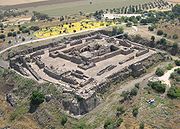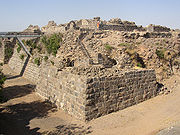.gif)
Belvoir Fortress (Israel)
Encyclopedia

Crusader states
The Crusader states were a number of mostly 12th- and 13th-century feudal states created by Western European crusaders in Asia Minor, Greece and the Holy Land , and during the Northern Crusades in the eastern Baltic area...
fortress in northern Israel
Israel
The State of Israel is a parliamentary republic located in the Middle East, along the eastern shore of the Mediterranean Sea...
, on a hill 20 kilometres (12.4 mi) south of the Sea of Galilee
Sea of Galilee
The Sea of Galilee, also Kinneret, Lake of Gennesaret, or Lake Tiberias , is the largest freshwater lake in Israel, and it is approximately in circumference, about long, and wide. The lake has a total area of , and a maximum depth of approximately 43 m...
. Gilbert of Assailly
Gilbert of Assailly
Gilbert of Assailly was Grand Master of the Knights Hospitallers from 1162/3 to 1170, when he resigned or was deposed. During his time at the head of the Hospitallers, they purchased the land for Castle Belvoir, at Kawkab al-Hawa, north of Beit She'an, and otherwise expanded their fortifications...
, Grand Master of the Knights Hospitaller
Knights Hospitaller
The Sovereign Military Hospitaller Order of Saint John of Jerusalem of Rhodes and of Malta , also known as the Sovereign Military Order of Malta , Order of Malta or Knights of Malta, is a Roman Catholic lay religious order, traditionally of military, chivalrous, noble nature. It is the world's...
, began construction of the castle in 1168. The restored fortress is located in Belvoir National Park. It is the best-preserved Crusader fortress in Israel.
History

Knights Hospitaller
The Sovereign Military Hospitaller Order of Saint John of Jerusalem of Rhodes and of Malta , also known as the Sovereign Military Order of Malta , Order of Malta or Knights of Malta, is a Roman Catholic lay religious order, traditionally of military, chivalrous, noble nature. It is the world's...
purchased the site from Velos, a French nobleman, in 1168. Standing 500 metres (1,640.4 ft) above the Jordan River Valley
Jordan Valley (Middle East)
The Jordan Valley forms part of the larger Jordan Rift Valley. It is 120 kilometers long and 15 kilometers wide, where it runs from Lake Tiberias in the north to northern Dead Sea in the south. It runs for an additional 155 kilometer south of the Dead Sea to Aqaba, an area also known as Wadi...
, the plateau commanded the route from Gilead
Gilead
In the Bible "Gilead" means hill of testimony or mound of witness, , a mountainous region east of the Jordan River, situated in the Hashemite Kingdom of Jordan. It is also referred to by the Aramaic name Yegar-Sahadutha, which carries the same meaning as the Hebrew . From its mountainous character...
into the Kingdom of Jerusalem
Kingdom of Jerusalem
The Kingdom of Jerusalem was a Catholic kingdom established in the Levant in 1099 after the First Crusade. The kingdom lasted nearly two hundred years, from 1099 until 1291 when the last remaining possession, Acre, was destroyed by the Mamluks, but its history is divided into two distinct periods....
and a nearby river crossing. To the north was the Sea of Galilee
Sea of Galilee
The Sea of Galilee, also Kinneret, Lake of Gennesaret, or Lake Tiberias , is the largest freshwater lake in Israel, and it is approximately in circumference, about long, and wide. The lake has a total area of , and a maximum depth of approximately 43 m...
and west were hills. The site of Belvoir Castle dominated the surrounding area, and in the words of to Abu Shama was "set admidst the stars like an eagle's nest and abode of the moon".
As soon as the order purchased the land they began construction of Belvoir Castle. While Gilbert of Assailly was Grand Master of the Knights Hospitaller the order gained around thirteen new castles, among which Belvoir was the most important. The fortress of Belvoir served as a major obstacle to the Muslim
Muslim
A Muslim, also spelled Moslem, is an adherent of Islam, a monotheistic, Abrahamic religion based on the Quran, which Muslims consider the verbatim word of God as revealed to prophet Muhammad. "Muslim" is the Arabic term for "submitter" .Muslims believe that God is one and incomparable...
goal of invading the Crusader Kingdom of Jerusalem
Kingdom of Jerusalem
The Kingdom of Jerusalem was a Catholic kingdom established in the Levant in 1099 after the First Crusade. The kingdom lasted nearly two hundred years, from 1099 until 1291 when the last remaining possession, Acre, was destroyed by the Mamluks, but its history is divided into two distinct periods....
from the east. It withstood an attack by Muslim forces in 1180. During the campaign of 1182, the Battle of Belvoir Castle
Battle of Belvoir Castle (1182)
In the campaign and Battle of Belvoir Castle , a Crusader force led by King Baldwin IV of Jerusalem sparred inconclusively with an Ayyubid army from Egypt commanded by Saladin. The theatre of operations included Eilat, the Transjordan, Galilee and Beirut.-Background:Saladin seized control of Egypt...
was fought nearby between King Baldwin IV of Jerusalem
Baldwin IV of Jerusalem
Baldwin IV of Jerusalem , called the Leper or the Leprous, the son of Amalric I of Jerusalem and his first wife, Agnes of Courtenay, was king of Jerusalem from 1174 to 1185. His full sister was Queen Sibylla of Jerusalem and his nephew through this sister was the child-king Baldwin V...
and Saladin
Saladin
Ṣalāḥ ad-Dīn Yūsuf ibn Ayyūb , better known in the Western world as Saladin, was an Arabized Kurdish Muslim, who became the first Sultan of Egypt and Syria, and founded the Ayyubid dynasty. He led Muslim and Arab opposition to the Franks and other European Crusaders in the Levant...
.
Following the Saladin
Saladin
Ṣalāḥ ad-Dīn Yūsuf ibn Ayyūb , better known in the Western world as Saladin, was an Arabized Kurdish Muslim, who became the first Sultan of Egypt and Syria, and founded the Ayyubid dynasty. He led Muslim and Arab opposition to the Franks and other European Crusaders in the Levant...
's victory over the Crusaders at the battle of the Horns of Hittin
Battle of Hattin
The Battle of Hattin took place on Saturday, July 4, 1187, between the Crusader Kingdom of Jerusalem and the forces of the Ayyubid dynasty....
, Belvoir was besieged. The siege lasted a year and a half, until the defenders surrendered on 5 January 1189. The fortifications of Belvoir were dismantled in 1217–18 by the Muslim rulers who feared the reconquest of the fortress by the Crusaders. In 1240 Belvoir was ceded to the Crusaders by agreement. However, lack of funds did not permit restoration of the fortifications and the fortress returned to Muslim control.
The Hebrew name, Kohav Hayarden, meaning Star of the Jordan, preserves the name of Kohav – a Jewish village which existed nearby during the Roman
Roman Empire
The Roman Empire was the post-Republican period of the ancient Roman civilization, characterised by an autocratic form of government and large territorial holdings in Europe and around the Mediterranean....
and Byzantine
Byzantine Empire
The Byzantine Empire was the Eastern Roman Empire during the periods of Late Antiquity and the Middle Ages, centred on the capital of Constantinople. Known simply as the Roman Empire or Romania to its inhabitants and neighbours, the Empire was the direct continuation of the Ancient Roman State...
periods.
Architecture
After the end of the Second World War, the study of Crusader castles experienced a lull. Syria, for instance, declared independence in 1946 and had little money to spare for archaeology. In Israel, the study of Crusader castles developed under Joshua PrawerJoshua Prawer
Joshua Prawer was a notable Israeli historian and a scholar of the Crusades and Kingdom of Jerusalem.His work often attempted to portray Crusader society as a forerunner to later European colonialist expansion...
. Its most significant discovery was made at Belvoir. Between 1963 and 1968 the Israel Department of Antiquities
Israel Antiquities Authority
The Israel Antiquities Authority is an independent Israeli governmental authority responsible for enforcing the 1978 Law of Antiquities. The IAA regulates excavation and conservation, and promotes research...
carried out excavations at the castle. Before the investigations, it had been assumed that Belvoir was a simple castle, with just a single enclosure. Excavations in the 1960s demonstrated the complex nature of early military architecture in the Kingdom of Jerusalem
Kingdom of Jerusalem
The Kingdom of Jerusalem was a Catholic kingdom established in the Levant in 1099 after the First Crusade. The kingdom lasted nearly two hundred years, from 1099 until 1291 when the last remaining possession, Acre, was destroyed by the Mamluks, but its history is divided into two distinct periods....
. Belvoir's design bore similarities to that of a Roman castra
Castra
The Latin word castra, with its singular castrum, was used by the ancient Romans to mean buildings or plots of land reserved to or constructed for use as a military defensive position. The word appears in both Oscan and Umbrian as well as in Latin. It may have descended from Indo-European to Italic...
: the inner enclosure was rectangular with towers at the corners, and large gatehouse in the middle of one wall, in this case the west.
Belvoir is an early example of the concentric castle
Concentric castle
A concentric castle is a castle with two or more concentric curtain walls, such that the outer wall is lower than the inner and can be defended from it. The word concentric does not imply that these castles were circular; in fact if taken too literally the term "concentric" is quite misleading...
plan, which was widely used in later crusader castles. The castle was highly symmetric, with a rectangular outer wall, reinforced with square towers at the corners and on each side, surrounding a square inner enclosure with four corner towers and one on the west wall. According to historian H. J. A. Sire, the principle of concentric design used at Belvoir "was to influence castle design for the next several centuries." Vaults on the inner side of both walls provided storage and protection during bombardments. The castle was surrounded by a moat 20 metres (65.6 ft) wide and 12 metres (39.4 ft) deep.
External links
- Cochav Hayarden (Belvoir) at the Israeli Parks Authority site.
- Photos of Belvoir fortress

